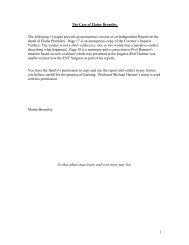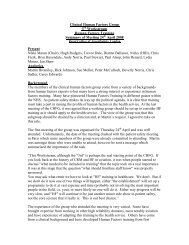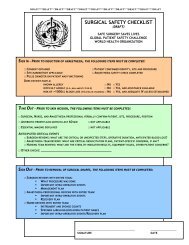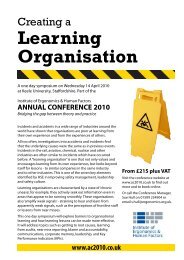The Essentials of Patient Safety - Clinical Human Factors Group
The Essentials of Patient Safety - Clinical Human Factors Group
The Essentials of Patient Safety - Clinical Human Factors Group
You also want an ePaper? Increase the reach of your titles
YUMPU automatically turns print PDFs into web optimized ePapers that Google loves.
<strong>The</strong> <strong>Essentials</strong> <strong>of</strong> <strong>Patient</strong> <strong>Safety</strong><br />
setting,<br />
classifying the error producing conditions and organisational factors in a single broad<br />
framework <strong>of</strong> factors affecting clinical practice (2)<br />
framework describes the contributory factors and influences on safety under seven<br />
broad headings:<br />
<br />
<br />
<br />
<br />
<br />
<br />
<br />
<strong>Patient</strong> factors. Thas the most direct influence on<br />
practice and outcome. Other factors such as personality, language and<br />
psychological problems may also be important as they can influence<br />
communication with staff.<br />
Task factors. <strong>The</strong> design <strong>of</strong> the task, the availability and utility <strong>of</strong> protocols<br />
and test results may influence the care process and affect the quality <strong>of</strong> care.<br />
Individual factors. Individual staff factors include the knowledge, skills and<br />
experience <strong>of</strong> each member <strong>of</strong> staff, which will obviously affect their clinical<br />
practice.<br />
Team factors. Each staff member is part <strong>of</strong> a team within the inpatient or<br />
community unit. <strong>The</strong> way an individual practises, and their impact on the patient,<br />
is influenced by other members <strong>of</strong> the team and the way they communicate and<br />
support each other.<br />
Working conditions. <strong>The</strong>se include the physical environment, availability <strong>of</strong><br />
equipment and supplies and the light, heat, interruptions and distractions that<br />
staff endure.<br />
Organisational factors. <strong>The</strong> team is influenced in turn by management actions<br />
and by decisions made at a higher level in the organisation. <strong>The</strong>se include<br />
policies for the use <strong>of</strong> locum or agency staff, continuing education, training and<br />
supervision and the availability <strong>of</strong> equipment and supplies.<br />
Institutional context. <strong>The</strong> organisation itself is affected by the institutional<br />
context, including financial constraints, external regulatory bodies and the<br />
broader economic and political climate.<br />
<strong>The</strong> investigation and analysis <strong>of</strong> clinical incidents<br />
<br />
ng clinical incidents, one <strong>of</strong> a<br />
number developed in healthcare (www.cpssq.org). <br />
the healthcare system revealing both strengths and vulnerabilities <strong>of</strong> the system(11).<br />
<strong>The</strong> London protocol aims to guide reflection on incidents in order to reveal these<br />
weaknesses.<br />
During an investigation information is gleaned from a variety <strong>of</strong> sources. Case<br />
records, statements and any other relevant documentation are reviewed. Structured<br />
interviews with key members <strong>of</strong> staff are then undertaken to establish the chronology<br />
<strong>of</strong> events, the main care delivery problems and their respective contributory factors, as<br />
perceived by each member <strong>of</strong> staff. <strong>The</strong> key questions are What happened (the<br />
outcome and chronology); How did it happen (the care delivery problems) and Why<br />
25








